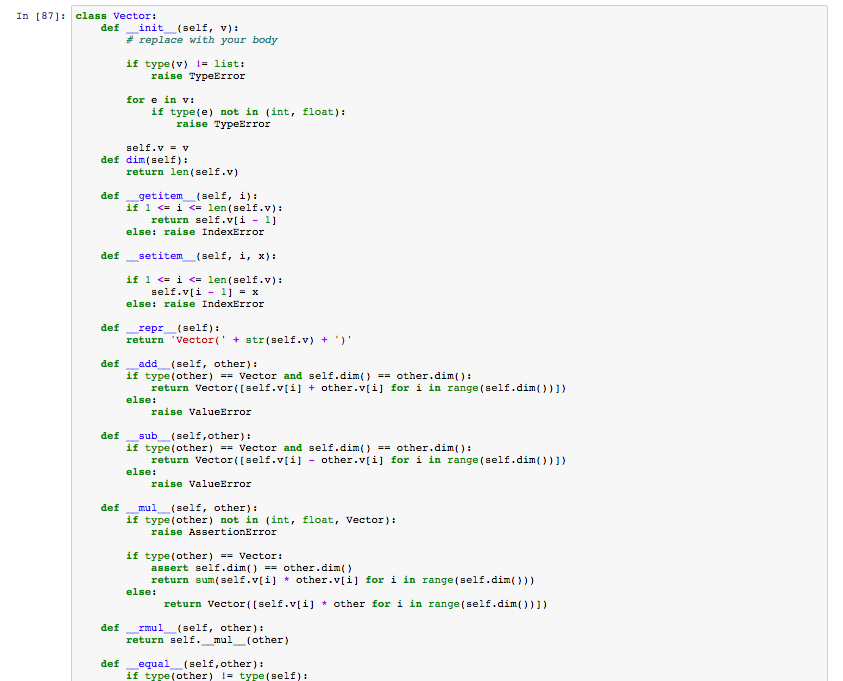Question
Can someone help me solve this Python Question? I'm not sure why I'm getting the assertion error. class Vector: def __init__(self, v): # replace with
Can someone help me solve this Python Question?
I'm not sure why I'm getting the assertion error.




class Vector: def __init__(self, v): # replace with your body if type(v) != list: raise TypeError for e in v: if type(e) not in (int, float): raise TypeError
self.v = v def dim(self): return len(self.v) def __getitem__(self, i): if 1 Question A2: Defining Vectors (9 points) Define class vector for n-dimensional vectors as follows: Vector(1) : Creates a new vector with dimension len (1) from list 1 of numbers; raises TypeError if l is not a list or not all of its elements are of type int or float .v.dim) Returns the dimension (length) of the vector. . v. getitem (i): Returns the -th component of the vector, where components are indexed starting from 1 ; raises 1ndexError ?f ? ?s less than 1 or greater than the dimension of the vector. v. setitem (i, x) : Sets the 1-th component of vector v to x, where components are indexed starting from 1; raises 1ndexError if ? ?S less than 1 or greater than the dimension of the vector. v. repr v.add if other is of a different dimension. v. Vector or if other is of a different dimension. ?: Returns the canonical string representation of the vector, see the example below. (other): Returns a new vector that is the component-wise sum of v and other; raises ValueError if other is not of type Vector or . . sub (other) : Returns a new vector that is the component-wise substraction of v and other; raises ValueError if other is not of type . . v. mul (other If other is of type int or float, returns a new vector resulting from the scalar multiplication of v with other, , i.e. with each component of v multiplied by scalar. If other is of type Vector, returns the dot product of v and other, which is the sum of the products of the corresponding components, raises ValueError if other is of different dimension in this case. If the type of other is none of Vector, int, float, raises AssertionError. . v. rmul (other Defined exactly like v. mul (other) . v. equal (self, other): Returns True if the values of the vector equals the values of other and are in the same order Python uses the following equivalent notations: v._getitem--( i ) str(v) v + otherv._add (other) v- otherv. sub (other) v * other = v. mul_ ( other) other * v = v.-.rmul. _ ( other) if other. mul--(v) is not defined - V. str ( equal (other) Question A2: Defining Vectors (9 points) Define class vector for n-dimensional vectors as follows: Vector(1) : Creates a new vector with dimension len (1) from list 1 of numbers; raises TypeError if l is not a list or not all of its elements are of type int or float .v.dim) Returns the dimension (length) of the vector. . v. getitem (i): Returns the -th component of the vector, where components are indexed starting from 1 ; raises 1ndexError ?f ? ?s less than 1 or greater than the dimension of the vector. v. setitem (i, x) : Sets the 1-th component of vector v to x, where components are indexed starting from 1; raises 1ndexError if ? ?S less than 1 or greater than the dimension of the vector. v. repr v.add if other is of a different dimension. v. Vector or if other is of a different dimension. ?: Returns the canonical string representation of the vector, see the example below. (other): Returns a new vector that is the component-wise sum of v and other; raises ValueError if other is not of type Vector or . . sub (other) : Returns a new vector that is the component-wise substraction of v and other; raises ValueError if other is not of type . . v. mul (other If other is of type int or float, returns a new vector resulting from the scalar multiplication of v with other, , i.e. with each component of v multiplied by scalar. If other is of type Vector, returns the dot product of v and other, which is the sum of the products of the corresponding components, raises ValueError if other is of different dimension in this case. If the type of other is none of Vector, int, float, raises AssertionError. . v. rmul (other Defined exactly like v. mul (other) . v. equal (self, other): Returns True if the values of the vector equals the values of other and are in the same order Python uses the following equivalent notations: v._getitem--( i ) str(v) v + otherv._add (other) v- otherv. sub (other) v * other = v. mul_ ( other) other * v = v.-.rmul. _ ( other) if other. mul--(v) is not defined - V. str ( equal (other)
Step by Step Solution
There are 3 Steps involved in it
Step: 1

Get Instant Access to Expert-Tailored Solutions
See step-by-step solutions with expert insights and AI powered tools for academic success
Step: 2

Step: 3

Ace Your Homework with AI
Get the answers you need in no time with our AI-driven, step-by-step assistance
Get Started


